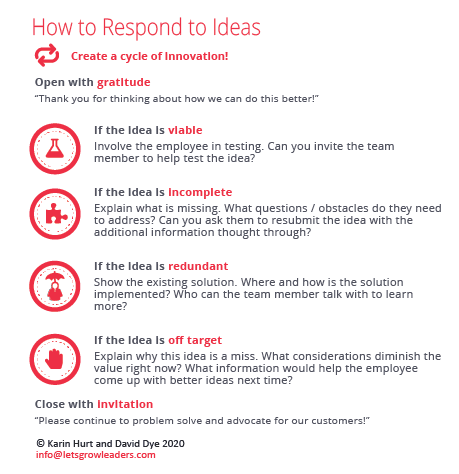When You Can’t Use an Idea, Pivot to Get More Ideas
“I need people to think.” Mattias, the CEO of a mid-sized human service provider, leaned back in his chair and sighed. “They have all kinds of ideas that just don’t work. The market’s changing and it’s like no one gets it. I hear you, I should listen, but what do I do when I can’t use an idea?”
Have you ever been in Mattias’s shoes? Your team has all kinds of ideas, but they’re ill-informed, off-target, or are just bad (it’s okay–just between us, we know it may have been a bad idea.)
The problem when you can’t use an idea because it’s bad or won’t work is that it’s often the first idea someone has. If you respond poorly to the idea you can’t use, you won’t get the ideas you can use.
This was Mattias’s problem. When people brought him an imperfect idea, he would get frustrated, tell them why it wouldn’t work and shoo them out of his office. They never came back.
Six Ways to Respond When You Can’t Use An Idea
1. Say Thank You
You get more of what you encourage and celebrate, less of what you criticize or ignore. If you want people thinking more deeply, thank them for it (even if it’s not quite as deep as you would have liked.)
Eg: “Thank you for taking the time to think about what would create a better experience for our customer. I really appreciate you putting your thoughts together and thinking deeply about this.”
2. Explain What Happened
Share the process. If you were able to trial their idea, focus-group it, or do anything with it, let them know what happened. What problems did it run into? Were there competing priorities? Did the solution break down or prove impractical during testing? Take a few seconds to respond and close the loop. It will energize the person who shared their idea–even if you couldn’t use it.
3. Clarify Your Focus
When you consistently get ideas that are off-target or don’t support strategic priorities, it’s a sure sign that you haven’t communicated those priorities clearly. Clarify the answers to these questions:
- What matters most right now?
- What ideas will help most?
- What will good ideas achieve when you put them to work?
Eg: “Our priority for the next quarter is to achieve 100% on-time delivery. We need ideas about how we speed up our QA process without compromising quality along with suggestions to decrease order assignment times.”
Use 5×5 communication when it’s important – share key messages five times, five different ways.
4. Ask How It Works
If you’ve shared the focus, checked for understanding, and someone brings you an idea that seems way off target, resist the urge to chastise them. Instead, use it as an opportunity for a micro-coaching session. Ask them how their idea will help achieve the goal. Taking a moment to be curious can help uncover great ideas or help a team member understand what a great idea looks like.
Eg: “Thanks for thinking about this with us. Can you walk me through how your idea would help us achieve 100% on-time delivery?”
You’ll get different answers to this question. Some will say, “Oh, I hadn’t really thought it through.” In which case you can reply “I’d love to get your thoughts one you’ve had a chance to think it through.”
At other times, they might surprise you with a linkage or explanation that you didn’t see.
5. Share Information
When you can’t use an idea, the problem might be that the person doesn’t have enough information to make a good suggestion. What information can you add that will help them think more deeply about the issue?
Do they need budget data or to better understand how their work fits into the bigger picture? Maybe they need comparative data from other departments or process.
Give them the information they need to think more strategically.
6. Invite More Ideas
Once you’ve clarified the focus and given them more information, invite them to keep thinking and to share what they come up with.
Eg: “Thanks for thinking about this with us. We tried a similar idea last year and ran into a problem – the QA team wasn’t learning about projects with enough lead time. If you have thoughts about a way to implement your suggestion and solve the lead time issue, I’d love to hear what you come up with.”
Your Turn
When you get an idea you can’t use, it’s an opportunity to help people think more deeply and to get even better thoughts. Leave a comment and share your best suggestion for how to respond when you get an idea you can’t use.









0 Comments